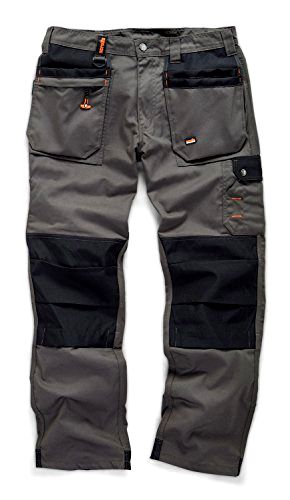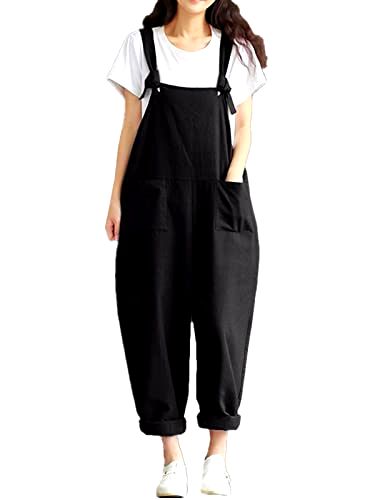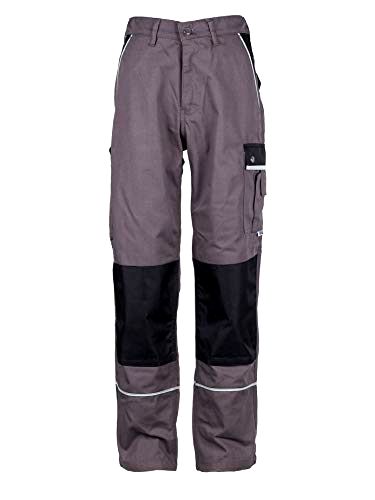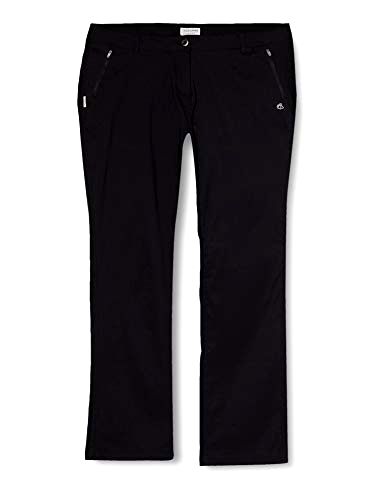Read Reviews
The Best Gardening Trousers

-
Scruffs Worker Plus Graphite Grey Work Trousers
-
Style Dome Women's Retro Loose Casual Dungarees
-
TMG Multi Pocket Work Trousers
-
Craghoppers Kiwi Pro Stretch Trousers
-
Garden Girl GGH0232 Classic Dungaree
Gardening Trousers Reviews
- Hardy and tear-resistant yet offer good breathability on hot days
- Multiple pockets in varying sizes for carrying small tools and other items
- Offer a small amount of water resistance
- Pockets are large enough to fit a modern smart phone
- Sections for inserting knee pads can make kneeling whilst gardening a lot more comfortable
- Kneepads may not be in the right place for tall users
- Trouser legs are baggy and could potentially get caught on branches or other obstacles
- Knee pads aren’t included so for additional knee support you’ll need to make a separate purchase
- Some customers report that the waist size is much larger than anticipated
If you’re constantly lacking pockets whilst gardening, these Scruffs Worker Plus Graphite Grey Work Trousers certainly offer plenty of places to squirrel away tools, pens, seeds and labels. Not only do they have loads of compartments, of various shapes and sizes, they’re also hardwearing and comfortable.
Coming in a range of sizes, the trousers are made from 35% cotton and 65% polyester. This combination makes them tough yet breathable, and the numerous pockets result in them resembling the Swiss-army-knife of the clothing world: they’re immensely multifunctional.
The compartments fasten in different ways, from zip closures to poppers, and there are fixed pockets as well as hanging ones; a total of ten versatile sections over all.
Also, the pockets don’t compromise on size in order to fit more onto the trousers – a modern smart phone will slip into several of the sections (and phones certainly aren’t known for being small nowadays!).
These trousers are relatively quick to dry, something that’s useful in the garden in case it rains or you accidentally get caught by the sprinkler. Plus, they have sections on the knees where pads can be inserted (bought separately) to make kneeling more comfortable.
When it comes to sizing, the waist can come up a little large, but most customers seem to find that they fit comfortably. The legs are also quite wide, which may suit some people more than others.
Nevertheless, these are some of the best gardening trousers if you want a pair that are highly versatile. Their construction is strong, and they are hardwearing. Plus, the ability to put knee pads in can make gardening a lot more comfortable.
Did you find this review helpful?
- Loose enough to fit layers underneath depending on the temperature
- Very easy to clean - machine washable and reasonably quick to dry
- Adjustable straps so suitable for both short and tall users
- Spacious pockets at the front for storing tools or a phone
- Large fit means they are suitable for gardening - comfortable and not restrictive while bending and working
- Material doesn’t offer much protection against brambles or thorns
- Holes for straps are not reinforced and may rip if pulled too tightly
It helps to have a quick and easy gardening outfit on hand, especially one that can be paired with layers depending on the weather. These Style Dome Women’s Retro Loose Dungarees are comfortable and light to wear, look stylish, and come in a range of colours.
They’re loose enough to be thrown on over leggings, thermals, jumpers, or vest tops – resulting in a versatile outfit for the garden. The strap length is easily adjusted, and there are different sizes available. Whilst the fit is true to size, sizing up can help fit layers underneath.
Made from 95% cotton and 5% viscose, these dungarees are lightweight yet sufficiently durable for casual day-to-day gardening. The fabric is reasonably thick but can crease easily; however, for working around the home and garden this shouldn’t cause too many problems.
Whilst the general quality is reasonable, the straps do tie onto the front bib by just a hole cut into the fabric – therefore, care needs to be taken not to tie the straps too forcefully, or the fabric may rip.
There are two pockets on the legs; they don’t fasten but they can still be useful for carrying smaller gardening items, or a phone, whilst outside. Seeing as trousers without pockets can be really frustrating, especially whilst working, it’s good to see some included.
Also, the length of the trousers is pretty much entirely customisable – they can be rolled up several times as necessary, creating a lot of flexibility.
Overall, these are some of the best gardening trousers if you want something that will be both stylish and practical. The sizing is very flexible, and because they’re easy to adjust they allow for a lot of movement whilst doing different jobs.
Did you find this review helpful?
- Very good quality - offer a lot of protection against brambles, thorns and gravel
- High-waisted elasticated waistband means they won’t slip down whilst bending down and kneeling in the garden
- Reinforced pocket can be used for sharper tools and secateurs
- Reinforced knees don't wear through easily even when used without knee pads
- Velcro and popper fastenings on pockets can be opened with gloves on
- Fabric may be too thick for working comfortably on hot summer
- Trouser legs are wide which can get in the way of certain jobs
These hardwearing yet lightweight TMG Multi-Pocket Work Trousers are comfortable to wear and have a well-considered design.
The high waistband is elasticated which prevents slippage, even when bending down, yet it isn’t too constrictive at the same time. There’s still a zip fastening as well, but the overall fit is improved by elastic.
The trousers are reinforced on the knees, and also have a pocket where kneepads can be inserted if required.
If your gardening work involves a lot of kneeling, you can avoid having to carry a mat around with you, and the kneepads will stay in as you move around; however, they don’t come included with the trousers.
The fabric is a mixture of 50% cotton and 50% polyester, making the trousers both breathable and durable – good protection is offered against thorns and brambles.
There are assorted pockets as well, closing with either poppers or Velcro, that will be easy to open even with gloves on.
Often, trousers in this ‘workwear’ style are only available in a few colours, but TMG has eight options to choose from, including black, red, and blue. They’re machine washable and long lasting.
All things considered, these are some of the best gardening trousers available if you’re after something particularly hardwearing. The fabric is durable, the stitching is strong, and the reinforced knees mean they don’t quickly wear through, even when knee pads aren’t used.
Did you find this review helpful?
- Very comfortable and stretchy so great for kneeling down or lifting heavy items
- Versatile design - can be worn both in the garden yet smart enough for out and about
- Retain water resistance even after multiple washes
- Material dries quickly
- Legs may get hot on sunny days
- No elastication in the waist so some customers have recommended sizing down
Craghoppers are a well-known brand when it comes to outdoor clothing, and their Kiwi Pro Stretch Trousers offer flexible movement which makes them comfortable to wear whilst gardening.
There are both women’s and men’s trousers available in this style, and they are water repellent which makes them useful for garden work – especially if the weather isn’t playing fair.
The black shade is smart-looking, making the trousers appropriate for other activities too such as walking and golf – they’re a generally useful purchase for outdoorsy people. Whilst the trousers can get a little warm in hot sun, because they absorb the heat, they still wick moisture away efficiently. Plus, there are other colours available too.
In terms of sizing, customer reports suggest that they tend to come up a little big, particularly in the women’s trousers. Therefore, it may be necessary to size down. However, if you want to wear other layers underneath, such as thermals or leggings, having some room to play with may be beneficial.
The fabric is 96% polyamide and 4% elastane and they stretch as you move. The trousers also feature reinforced heel tape for added durability – stopping the bottom of the trousers from wearing out too quickly.
These are some of the best gardening trousers if you’re after a pair that will be useful for all-round outdoor activities. Their water resistance, stretch and pockets make them useful in the garden, but they’re also smart enough to wear outside the home.
Did you find this review helpful?
- Multiple pockets and clips are perfect for storing tools and essentials
- Very comfortable thanks to the relaxed, baggy fit
- Easy to clean in the washing machine after use
- Zip down the front makes them easier to take on and off than unclipping shoulders
- May need to be rolled up if wearer is under 5'5" - the legs can be very long
The Garden Girl GGH0232 Classic Dungaree combines retro land girl styling with quirky decorative touches. The result? Comfortable utility clothing that is both feminine and practical.
Made from 100% cotton, the dungarees are durable, easy to wash and versatile enough for working in the garden. They have large clip fastenings for the shoulder straps, as well as a front zip; this makes them easy to get in and out of without constantly adjusting the shoulders.
The pockets aren’t just practical, but also add a kitsch appearance, using floral and gingham fabric to add decorative accents to the brown dungarees. There are lots of places to put seeds, string, pencils, plant markers and so on, plus a detachable phone holder than can be hooked on to one of the many D-rings.
Knee pads can be purchased separately and added in if required, and the knee pockets are reinforced with 100% nylon to stop them from easily wearing through.
Whilst these dungarees come up true to size, they tend to be a little long and may require rolling up for any wearers under 5’5”. There’s Velcro on the ankle cuffs, to make tightening the legs easier, but this isn’t necessarily a useful solution if the legs are too long.
Other than this, they are some of the best gardening trousers for women who want durability, style and plenty of pockets.
Did you find this review helpful?
How to Choose the Best Gardening Trousers
The right gardening attire is key when it comes to keeping you cool, comfortable and dry.
Whether you’re gardening in the height of summer or the depths of winter, a pair of gardening trousers can help to improve your gardening experience. In a country that’s not exactly renowned for reliable sunshine, we need all the help we can get when it comes to protective outdoor gear…!
If you’re considering purchasing a pair of gardening trousers but you’re not sure what to look for, the following tips will help you to make an informed decision.
Benefits of Gardening Trousers
There’s a number of advantages to wearing special gardening trousers over shorts, jeans or tracksuit bottoms.
- Not ruining your other clothes. Perhaps the main benefit of having specific gardening attire. It can be tempting just to throw on t-shirts, jeans, or leggings before tackling the garden, but you may find that several of your clothes quickly get condemned to the scrap heap. In order to preserve your existing clothes, it can help to wear something more durable in the garden.
- Water resistance/waterproofing. Kneeling down to dig, plant, or tend to your produce can quickly result in soggy knees. A pair of gardening trousers will keep your legs dry whilst you work. They also won’t get weighed down if it rains or you accidentally catch yourself with the watering can.
- Scratch resistant. Depending on their thickness, gardening trousers can be scratch resistant. This reduces the chance of brambles or thorns damaging your clothing or scratching your legs.
- Comfortable. If you’re used to gardening in jeans, you’re in for a treat when it comes to gardening trousers. Ultra-flexible and very comfortable, gardening trousers are easy to work in and allow for a greater range of movement.
- Breathable. Another great thing about gardening trousers is that they’re usually very breathable. They’ll both protect your legs and prevent them from getting too hot.
- Storage pockets. Many gardening trousers come with ample pockets so you’ll have space to store various tools. While jeans or shorts tend to have just a couple of pockets, gardening trousers are usually designed with utility in mind.
- Knee protection. Gardening trousers can help protect your knees whilst you’re working – they often have reinforced knee areas, and can also have pockets where you can insert knee pads.
Level of Protection
Some gardening trousers will simply be a loose and comfortable option to wear in the garden. However, there are some styles, which are more specifically designed for gardening, that offer more durability and protection.
The thickness of the fabric will be the first thing to look out for. Trousers made from 100% cotton may be thick – like denim – or thin – like a sheet. It’s necessary to find out the weight of the cotton in order to understand how protective the trouser will be.
If they are a cotton/polyester blend, they will be more durable (although not as breathable because polyester is a synthetic fabric).
Reinforced components will increase protection and durability. Some gardening trousers will have reinforced knees, crotches, or cuffs, adding more protection in areas that tend to see a lot of wear.
It’s also not uncommon for the knees to have a pocket where a knee pad can be inserted. While some people opt for using a garden kneeler, using trouser inserts is undoubtedly more convenient – they’ll stay in the trousers as you get up and move around.
Water-resistant trousers will offer some protection against rain and moisture. However, if you’re kneeling on damp grass for some time, it’s likely to seep through. Waterproof trousers will keep your legs completely dry, but aren’t always as comfortable.
It’s important to note that if you plan on using your trousers whilst operating machinery, they should have extra safety features. Chainsaw trousers for example, should meet the BS EN381-5 safety standard so that they can fully protect your legs.
Comfort and Flexibility
If you spend a lot of time out in the garden, it’s essential that your trousers are comfortable for long periods (which is why fully waterproof trousers might not be a great option). They should allow for a full range of movement, stay up whilst bending down, and be breathable.
Ideally, gardening trousers should keep you cool in the summer and warm in the winter. If there is a bit of extra room in the trousers, you should be able to wear thermals underneath when it’s cold.
An elasticated waist can help gardening trousers stay up, hopefully avoiding that uncomfortable feeling of cold air on an exposed back. Drawstrings and elastic can help with customising the fit.
Selecting the Right Material
Gardening trousers are usually made from polyester, or a polyester and cotton blend (polycotton).
Polyester is one of the most popular options and it’s also the cheapest. Polyester is relatively durable and lightweight. It’s naturally water repellent, and has good resistance to heat and chemical degradation. Plus, it’s very easy to wash and won’t shrink.
The disadvantages to polyester are that it’s not breathable and can be uncomfortable to wear next to the skin, especially in hot weather. When wet, it can feel a little clammy and it also retains odours.
Polycotton is made using a blend of polyester and cotton. This combines the best qualities of polyester, with the advantages of cotton.
Cotton is relatively strong, soft and breathable. This makes polycotton naturally more comfortable than polyester fabric. It tends to keep you cool in the summer and warm in the winter.
Unlike polyester, when cotton gets wet, it absorbs water which will help keep you cool and prevent that clammy feeling. It’s also hypoallergenic and doesn’t irritate the skin.
You may notice that a lot of gardening trousers are made with multiple layers of material. This will add to the durability, but you may find it reduces the breathability of your trousers.
Number of Pockets
Pockets may or may not be of interest to you when gardening. For some people, it can be useful to have seeds, string, pencils etc. easily to hand, but for others it can feel inhibiting to move around with all these objects on board.
If you have a gardening basket or box that you carry around with you, you might not feel that pockets are a priority. Nevertheless, gardening trousers can often have up to ten pockets, with zip, popper and Velcro fastenings, making them very practical.
Gardening Trousers FAQs
Whilst not a necessity, gardening trousers can be useful for several reasons. They can stop you from ruining other clothes out in the garden, providing a go-to outfit with no thought required. Much like wearing overalls for painting, when wearing gardening trousers you are free from the fear of ruining your clothes, and can get stuck into the task uninhibited. If the trousers are durable and reinforced, they will offer protection from thorns, brambles and nettles. If they’re water resistant, you won’t find that they get uncomfortably damp, which should keep you warmer whilst working in the garden.
If it’s raining, a pair of waterproof trousers will stop you from getting wet through. Keeping dry means keeping warm, which can allow you to stay outside for longer. Otherwise, water-resistant trousers will be sufficient – they’ll keep light moisture out, but will be more breathable than fully waterproof trousers. Wearing trousers as opposed to shorts can offer protection from brambles, thorns and nettles.
Even on hot days, you should opt for a long-sleeved shirt with sun protection. Alternatively, be sure to lather your arms in sun cream!
Shoes should be grippy and breathable. If you’re digging, you’ll need a thick sole that’ll protect the bottom of your foot from the spade. Whilst backless garden shoes aren’t the sturdiest on the market, they’re good for casual gardening. They can be left by the door and slipped on when needed.
Of course, if you are operating powerful equipment you should wear the right safety gear. Depending on what task you’re tackling, this could mean a helmet, eye protection, gloves and goggles. In this case, cheap rubber garden shoes are inappropriate, and you should opt for something more sturdy.
Knee pockets make it possible to insert knee pads into the trousers and offer extra protection whilst working in the garden. Kneeling down can be painful on the knees, so extra cushioning is often welcome. Whilst some gardeners use a garden kneeler, which is a foam cushion, having knee pads directly in the trousers can be more convenient – you don’t have to keep moving the cushion around with you (and risk misplacing it).






Share